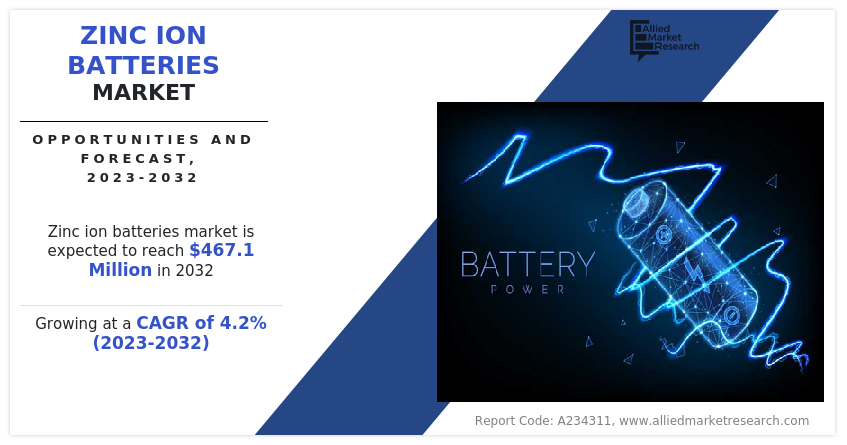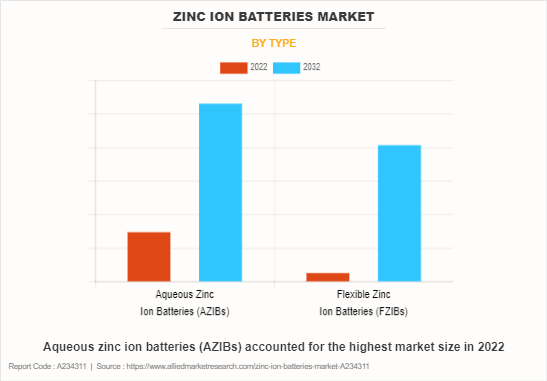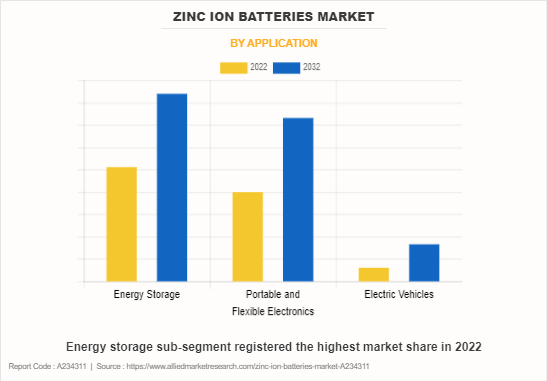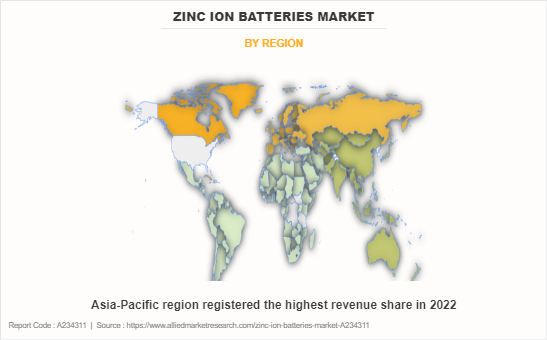Zinc Ion Batteries Market Research, 2032
The Global Zinc Ion Batteries Market size was valued at $314.6 million in 2022, and is projected to reach $467.1 million by 2032, growing at a CAGR of 4.2% from 2023 to 2032.
Zinc ion batteries represent a potential future in energy storage technology, providing an appealing alternative to current lithium-ion batteries. These batteries use the plentiful and inexpensive element zinc as a crucial component in their electrochemical processes, offering not just improved performance but also sustainability in a fast-changing energy landscape.

With the urgent need for scalable and efficient energy storage solutions to enable renewable energy integration while also meeting the needs of portable devices and electric cars, zinc-ion batteries emerge as a compelling alternative set to transform the future of energy storage. Zinc ion batteries industry work on the same basic principles as standard lithium-ion batteries, with an anode, cathode, and electrolyte facilitating the movement of ions between electrodes during charge and discharge cycles. However, substituting zinc for lithium has numerous significant advantages. For initial reasons, zinc has a substantially larger theoretical capacity than lithium, resulting in superior energy density and longer-lasting battery performance.
Key Takeaways of Zinc Ion Batteries Market Report
- Based on type, the aqueous zinc ion batteries sub-segment emerged as the global leader in 2022 and the flexible zinc ion batteries sub-segment is anticipated to be the fastest growing during the forecast period.
- Based on application, the energy storage sub-segment emerged as the global leader in 2022 and the portable & flexible electronics sub-segment is predicted to show the fastest growth in the upcoming years.
- Based on region, Asia-Pacific registered the highest market share in 2022 and is projected to maintain its position during the forecast period.
Segment Overview
The zinc ion batteries market is segmented into Type, Application, and Region.

By type, the aqueous zinc ion batteries (AZIBs) sub-segment dominated the global zinc ion batteries market opportunity in 2022. The increasing interest in aqueous zinc ion batteries is driven by their safety, environmental friendliness, and cost-effectiveness, particularly attributed to water-based electrolytes. The use of nanostructured carbons in composite positive electrodes and as protection for metallic zinc anodes enhances the electrochemical energy storage properties, showcasing the versatility of these materials. The efficient performance of cathodes, such as H2V3O8 nanowire/graphene, demonstrates remarkable capacity, cycling stability, and specific energy.
The inherent advantages of organic cathode materials in aqueous zinc ion batteries, including low cost and potential for biodegradation, further contribute to the attractiveness of aqueous zinc ion batteries in grid applications. In addition, the demand for low-cost and sustainable grid energy storage solutions, especially in countries like India and China, is expected to drive the adoption of aqueous zinc ion batteries, offering a reliable and environmentally friendly alternative to conventional lithium-ion batteries. The evolving landscape of energy storage, along with the increasing focus on renewable sources, positions aqueous zinc ion batteries as a potential solution in the transition to a cleaner and more sustainable energy future. These factors are anticipated to boost the zinc ion batteries market demand in the coming years.

By application, the energy storage sub-segment dominated the global zinc ion batteries market share in 2022. Batteries are pivotal in the global shift towards sustainable energy, playing a crucial role in combating climate change by supporting the transition to renewable energy sources like solar and wind. The growing inclination towards renewable energy, necessitates robust stationary energy storage systems for reliable grid-level energy dispatch. Traditionally, lithium-ion batteries have dominated utility-scale energy storage; however, the rising costs of raw materials and increasing supply chain disruptions urge exploration of alternative technologies. Rechargeable zinc-ion batteries emerge as a promising solution, catering to the specific requirements of stationary applications where factors like cost, safety, and durability outweigh the importance of battery weight.
The advantages of Zn-ion battery, including their low projected manufacturing costs, high safety, excellent recyclability, and versatility for stationary energy storage, position them as a compelling alternative to lithium-ion batteries. As the demand for energy storage installations continues to grow amid global efforts to decarbonize the power sector, these batteries present an innovative and sustainable option poised to contribute significantly to the evolving energy landscape. Zinc ion batteries exhibit low manufacturing costs and high safety, making them a promising technology for stationary applications. The rising global emissions from the power sector highlight the urgency of transitioning to renewable energy sources and these batteries present a viable solution to enhance grid reliability, reduce demand charges, and contribute to the widespread deployment of renewable energy technologies.

By region, Asia-Pacific dominated the global zinc ion batteries market in 2022. The Asia-Pacific zinc ion batteries market size has witnessed a substantial upswing, driven by several factors that align with the region's dynamic energy landscape. Asia-Pacific, home to some of the world's fastest-growing economies such as India, China, Japan, Australia, and others, is experiencing a surge in energy consumption, driven by industrialization, urbanization, and a growing population. This rising demand necessitates robust and sustainable energy storage solutions, creating a conducive environment for the adoption of innovative technologies like zinc ion batteries. In addition, one of the key factors driving the demand for zn-ion battery in the region is the rising emphasis on clean and renewable energy sources.
As countries strive to meet their climate goals and reduce dependence on traditional fossil fuels, the integration of solar and wind energy into the power grid has gained momentum. The intermittent nature of these renewable sources necessitates effective energy storage solutions, as zinc-based energy storage offers safety, cost-effectiveness, and abundance of raw materials is gaining significant popularity among battery manufacturers. These factors are anticipated to drive the Asia-Pacific zinc ion batteries market growth in the upcoming years.
Competitive Analysis
The key players profiled in this report include Enerpoly AB, Æsir Technologies, Inc., Salient Energy, ZincFive, FDK CORPORATION, Eastman Kodak Company, ZeniPower (Zhuhai Zhi Li) Battery Co., Ltd., Primus Power, Shenzhen BetterPower Battery Co., Ltd., and GPIndustrial. Investment in manufacturing capacity and market expansion are common strategies followed by major market players. For instance, on February 9, 2023, Enerpoly developed configurable, modular zinc-ion batteries for stationary storage applications. They are suitable for short- to medium-duration storage applications of 2 to 10 hours.
Market Dynamics
One of the key reasons driving the development and deployment in the zinc ion batteries industry is the increasing need for cost-effective and environmentally friendly energy storage options
Traditional lithium-ion batteries, while efficient, present several obstacles, including finite lithium supplies, safety issues, and relatively high production costs. Zinc, on the other hand, is abundant, affordable, and easily recyclable, making zinc-ion batteries an attractive option. Furthermore, the scalability of zinc-ion technology makes it ideal for large-scale energy storage applications including renewable energy integration and grid stabilization. Another key benefit of zinc-ion technology is the possibility for great energy density. While lithium-ion batteries have traditionally led the market in terms of energy density, ongoing R&D efforts in zinc-ion chemistry aim to close the gap. Improvements in electrode materials, electrolyte formulations, and cell designs have the potential to increase the energy density of zinc-ion batteries, making them more suitable for a wider range of applications, such as portable devices and electric cars.
One of the major factors limiting the zinc-ion batteries market is their lower energy density compared to lithium-ion competitors.
Despite recent advances, zinc-ion batteries still fall short in terms of energy density, restricting their use in high-energy-demand situations such as electric vehicles (EVs) and grid-scale energy storage. This restriction derives from the fundamental properties of zinc chemistry, which restrict the reversible intercalation of zinc ions inside battery electrodes. Therefore, zinc-ion batteries may not meet the performance requirements of some demanding applications, necessitating additional research and technical advancements to increase their energy density. Furthermore, the scarcity of appropriate electrolytes compatible with zinc chemistry is another limiting factor for zinc ion batteries technology. Unlike lithium-ion batteries, which have a well-established repertory of electrolyte formulations, zinc-ion batteries require electrolytes that can enable effective zinc plating and stripping operations while avoiding negative side effects.
Synergies with complementary technologies, such as renewable energy sources and smart grid systems, open up new paths for the spread of zinc-ion batteries in the expanding energy environment.
As the globe shifts to a more sustainable energy paradigm, the integration of intermittent renewables such as solar and wind demands effective energy storage systems to reduce supply-demand mismatches and improve grid stability. Zinc-ion batteries provide an appealing option for storing extra renewable energy during times of abundance and discharging it when needed, supporting wider adoption of clean energy generation and hastening the transition to a carbon-neutral future. The ongoing R&D efforts in the field of zinc-ion batteries highlight their potential for continuous improvement and market expansion in the upcoming years. Scientists and engineers across the world are actively refining battery chemistries, optimizing electrode designs, and improving manufacturing processes in order to achieve more performance enhancements and cost reductions. These factors are anticipated to have a positive impact on the zinc ion batteries market forecast in the coming years.
Key Benefits for Stakeholders
- The report provides exclusive and comprehensive analysis of the global zinc ion batteries market trends along with the market forecast.
- The report elucidates the zinc ion batteries market overview along with key drivers, and restraints of the market. It is a compilation of detailed information, inputs from industry participants and industry experts across the value chain, and quantitative and qualitative assessment by industry analysts.
- Porter‐™s five forces analysis helps analyze the potential of the buyers & suppliers and the competitive scenario of the market for strategy building.
- The report entailing the zinc ion batteries market analysis maps the qualitative sway of various industry factors on market segments as well as geographies.
- The data in this report aims on market dynamics, trends, and developments affecting the market growth
Zinc Ion Batteries Market Report Highlights
| Aspects | Details |
| Market Size By 2032 | USD 467.1 million |
| Growth Rate | CAGR of 4.2% |
| Forecast period | 2022 - 2032 |
| Report Pages | 320 |
| By Type |
|
| By Application |
|
| By Region |
|
| Key Market Players | Eastman Kodak Company, ZeniPower (Zhuhai Zhi Li) Battery Co., Ltd., GPIndustrial, Salient Energy, zincfive, inc., Shenzhen BetterPower Battery Co., Ltd., FDK CORPORATION, Æsir Technologies, Inc., Primus Power Corporation, Enerpoly AB |
The zinc ion batteries market size is expected to grow due to rising demand for energy storage solutions globally. In addition, the market is driven by advancements in battery technology.
The major growth strategies adopted by the zinc ion batteries market players are R&D investments and brand building.
Asia-Pacific will provide more business opportunities for the global zinc ion batteries market in the future.
Enerpoly AB, Æsir Technologies, Inc., Salient Energy, ZincFive, FDK CORPORATION, Eastman Kodak Company, ZeniPower (Zhuhai Zhi Li) Battery Co., Ltd., Primus Power, Shenzhen BetterPower Battery Co., Ltd., and GPIndustrial. are the major players in the zinc ion batteries market.
The aqueous zinc ion batteries (AZIBs) sub-segment of the type segment acquired the maximum share of the global zinc ion batteries market in 2022.
Energy storage system companies are the major customers in the global zinc ion batteries market.
The report provides an extensive qualitative and quantitative analysis of the current trends and future estimations of the global zinc ion batteries market from 2022 to 2032 to determine the prevailing opportunities.
Zinc ion batteries industrial application is expected to experience a growth in adoption, as various industries, including manufacturing, logistics, telecommunications, and aerospace, have diverse energy storage needs for powering equipment, machinery, communication systems, and remote installations.
Scaling up manufacturing capacity, expansion into electric vehicle industry, and surge in demand for integration with renewable energy systems to drive the global zinc ion batteries market.
Loading Table Of Content...
Loading Research Methodology...



